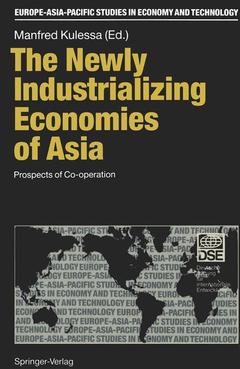The Newly Industrializing Economies of Asia, Softcover reprint of the original 1st ed. 1990 Prospects of Co-operation Europe-Asia-Pacific Studies in Economy and Technology Series
Langue : Anglais
Coordonnateur : Kulessa Manfred

Where development is concerned, our language and perhaps our way of thinking often ap pear somewhat distorted. If anything, the Asian economies with their most impressive and dynamic growth should logically be called developing countries. Instead, we call them threshold countries, newly industrializing countries (NICs) or newly industrializing eco nomies (NIEs), the latter term taking into account the Chinese argument that Hong Kong and Taiwan should not be considered countries. During the eighties, when Latin American NICs became the main victims of the debt crisis, the NIEs of East Asia (EANIEs), the little tigers or dragons, presented most impres sive examples of growth through orientation to world trade, fitting well into the Japanese 'flying-geese' concept. Naturally, questions were raised as to the reasons for this success, the lessons other countries could draw from it, and the outlook for the future. At the same time, the establis hed industrial countries wanted to know what NIE competition might mean for them. In 1988, the OECD published a study entitled "The NIEs -Challenge and Opportunity for OECD Industries". The NIBs had become a fashionable object of research and debate. In Western Europe, where countries are preparing for a period offurtherintegration and East-West cooperation, it seems worth-while to also consider the role ofthe EANIEs and the options for cooperation they represent. Moreover, the NIEs themselves are following development in Europe with some concern and are trying to adjust to the new situation as it emerges.
Summary Report.- One The Asian NIEs and the Asia-Pacific Region.- Country Issues.- Korea: A Newly Industrializing Economy Market Opening, Internationalization and International Cooperation.- Korea 2000: Economic and Social Targets and Development Strategies.- Korea’s Long-Term Trade Prospects and Policies to the Year 2000.- Taiwan: Claims and Strategies towards Europe.- The Case for Taiwan’s Role in the OECD.- The Significance of Taiwan’s Rejoining GATT.- The Hong Kong Economy in a Changing International Economic Environment.- Regional Issues.- Some Reflections on Prospects for Regional Co-operation in the Asian-Pacific Region.- ASEAN Reality and Perspective.- NIE-Japanese Strategic Interdependence in the Pacific Basin.- The East Asian NICs and South Asia Reality.- Thailand and the So-Called NIEs.- Market Forces in the Asian NIEs.- State Intervention, State Involvement and Market Forces — Singapore and South Korea.- The Development of Small and Medium-Sized Enterprises in the Asian NIEs — Business Opportunities for Western Europe?.- Two The Relations between the Asian NIEs and Europe in a Worldwide Perspective.- The NIEs and Major World Economic Issues.- A World Scenario: The Emergence of Three Main Trading Zones The European Community/Japan — East Asia — Pacific/USA — Canada.- The Concept of the International Division of Labour and Principles of Cooperation.- Technology and Global Competition: The Challenge ahead for the NIEs.- NIEs as Models for Establishing a Highly Competitive Industrial Base: What Lessons to Learn?.- The NIEs and Europe.- Europe 1992 and the NIEs.- Recent Trade Patterns between NIEs and Western Europe.- The NIEs Viewed from the German and European Perspectives.- The Ability of the German Economy to Face Opportunities and Challenges of Emerging NIEs.- Recommendations for a European Policy towards the Asian NIEs.- Annexes.- Statistical Country Profiles by Harald Mücke.- Programme of the International Round Table Meeting.- List of Participants and Authors.
Date de parution : 01-2012
Ouvrage de 360 p.
17x24.2 cm
Disponible chez l'éditeur (délai d'approvisionnement : 15 jours).
Prix indicatif 105,49 €
Ajouter au panierThème de The Newly Industrializing Economies of Asia :
© 2024 LAVOISIER S.A.S.


